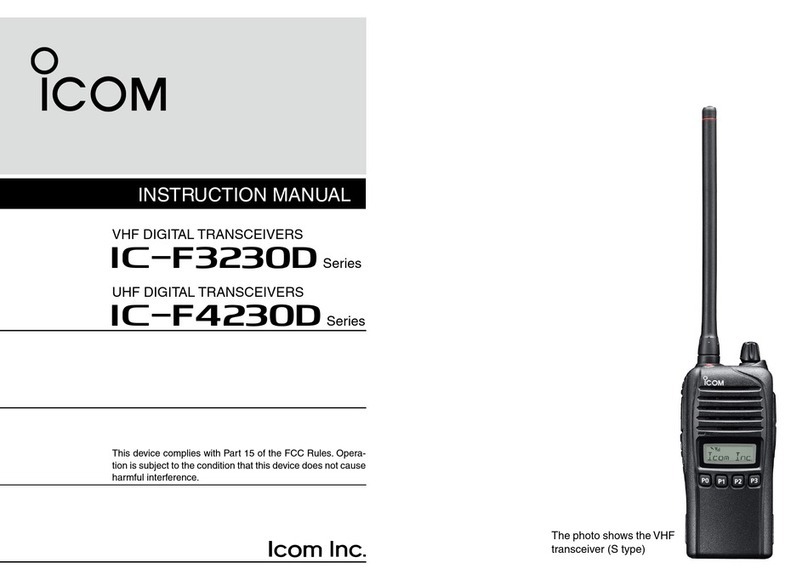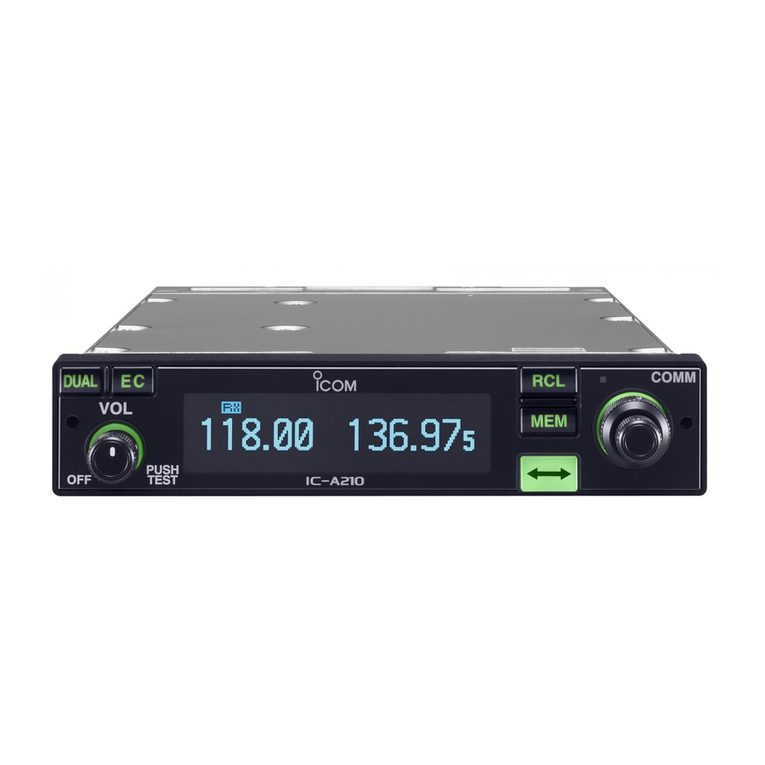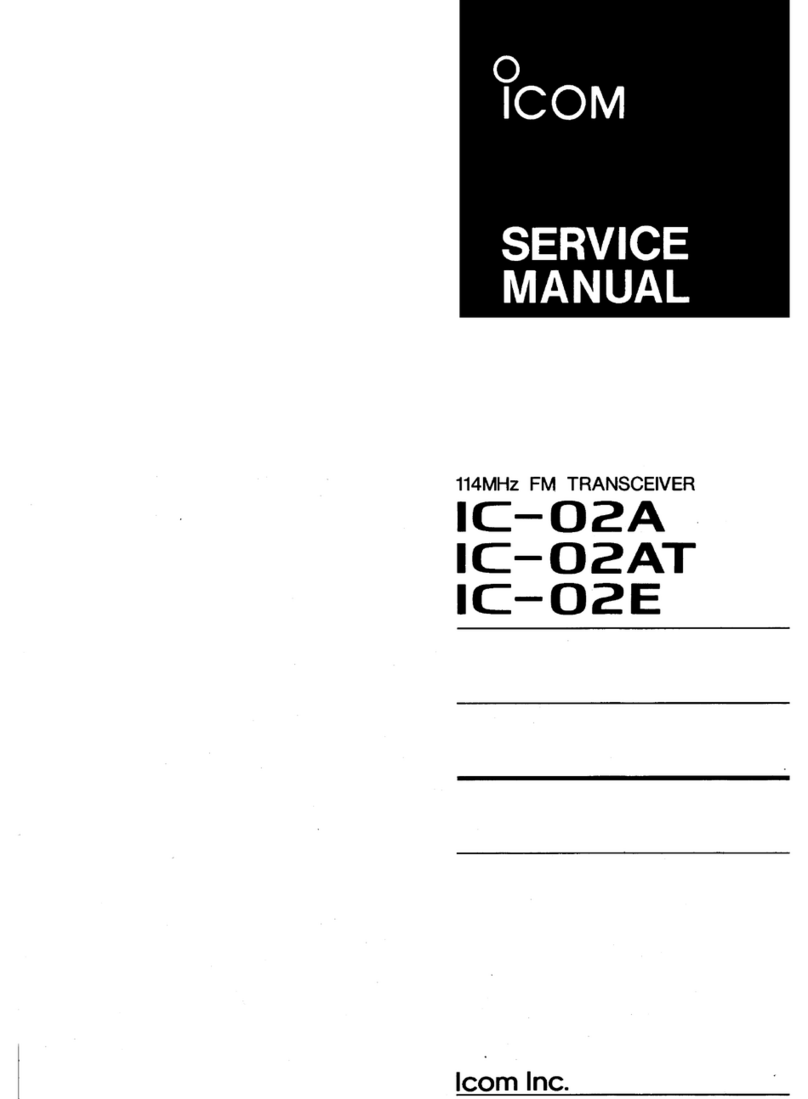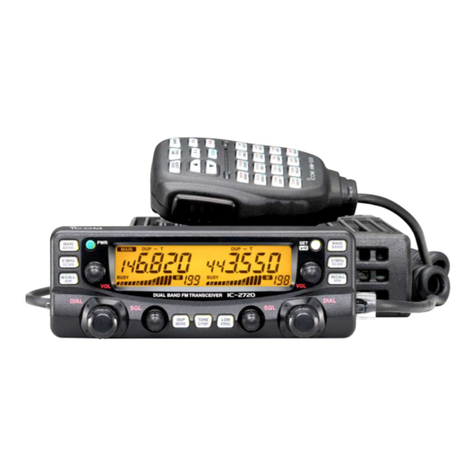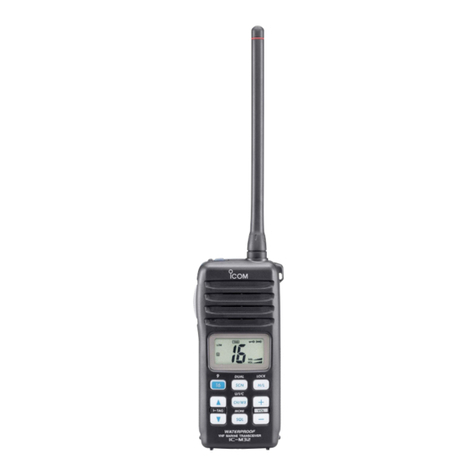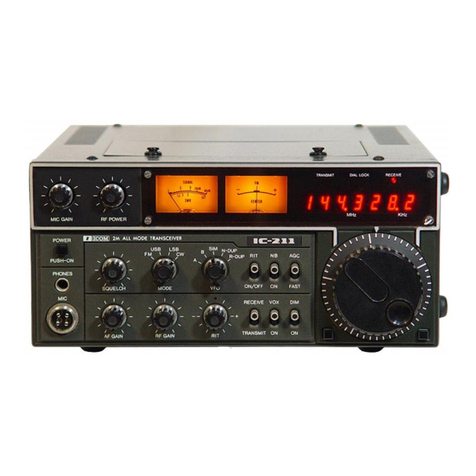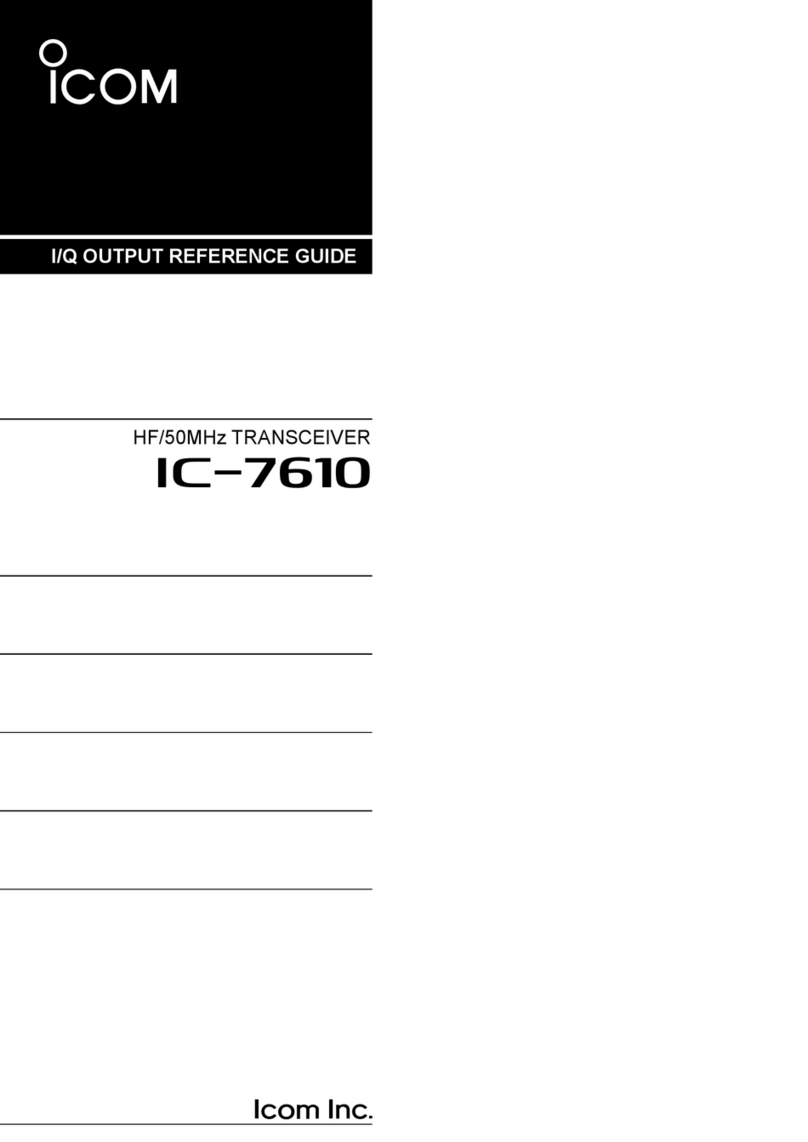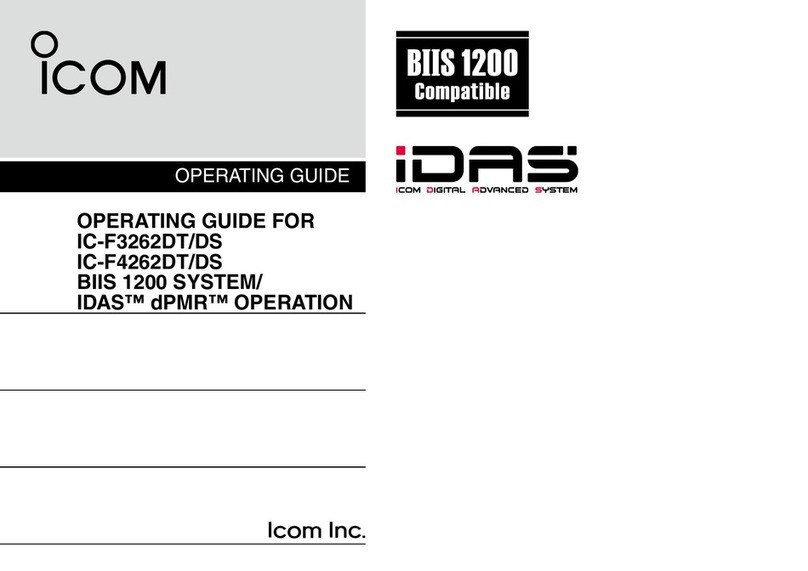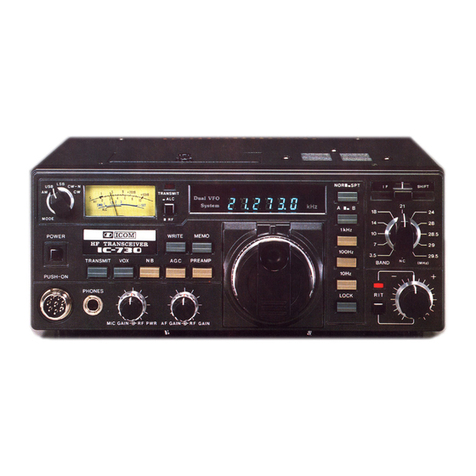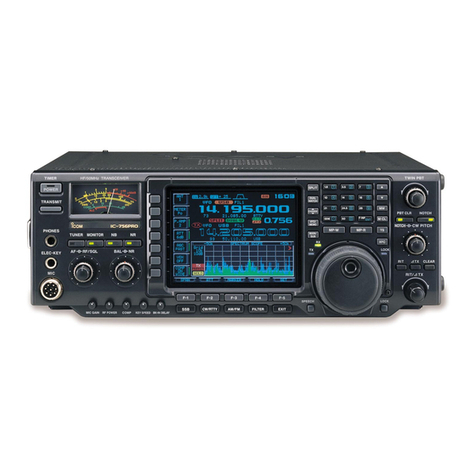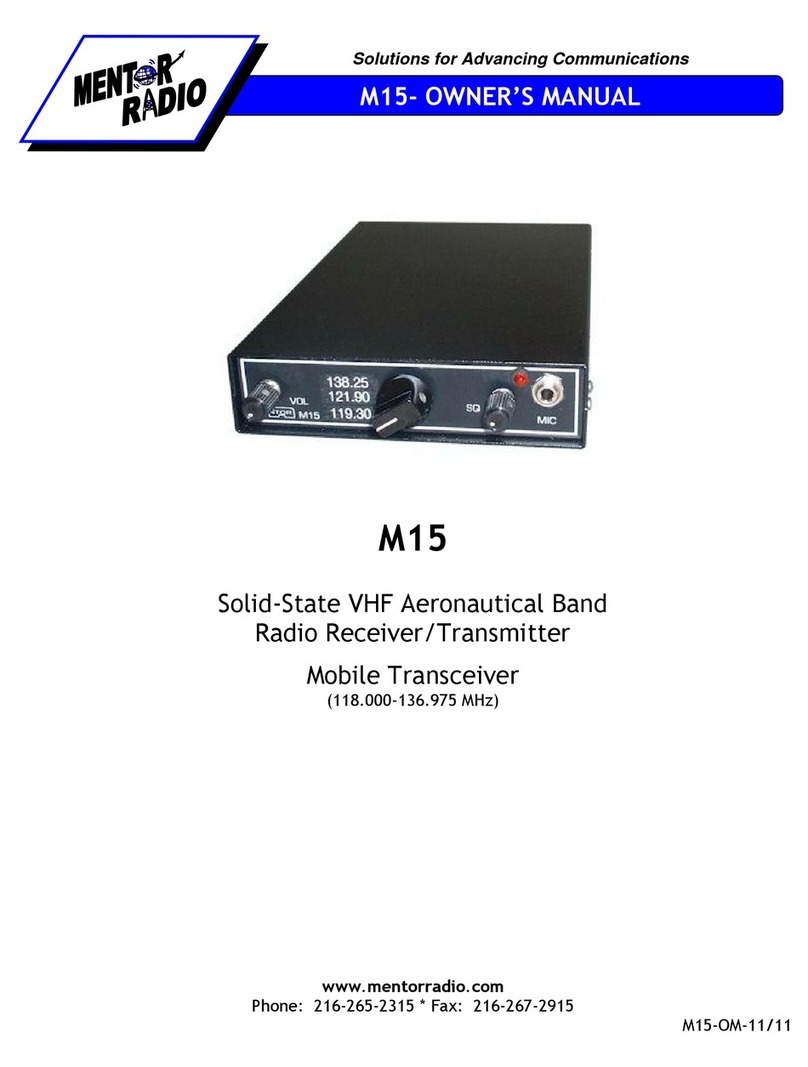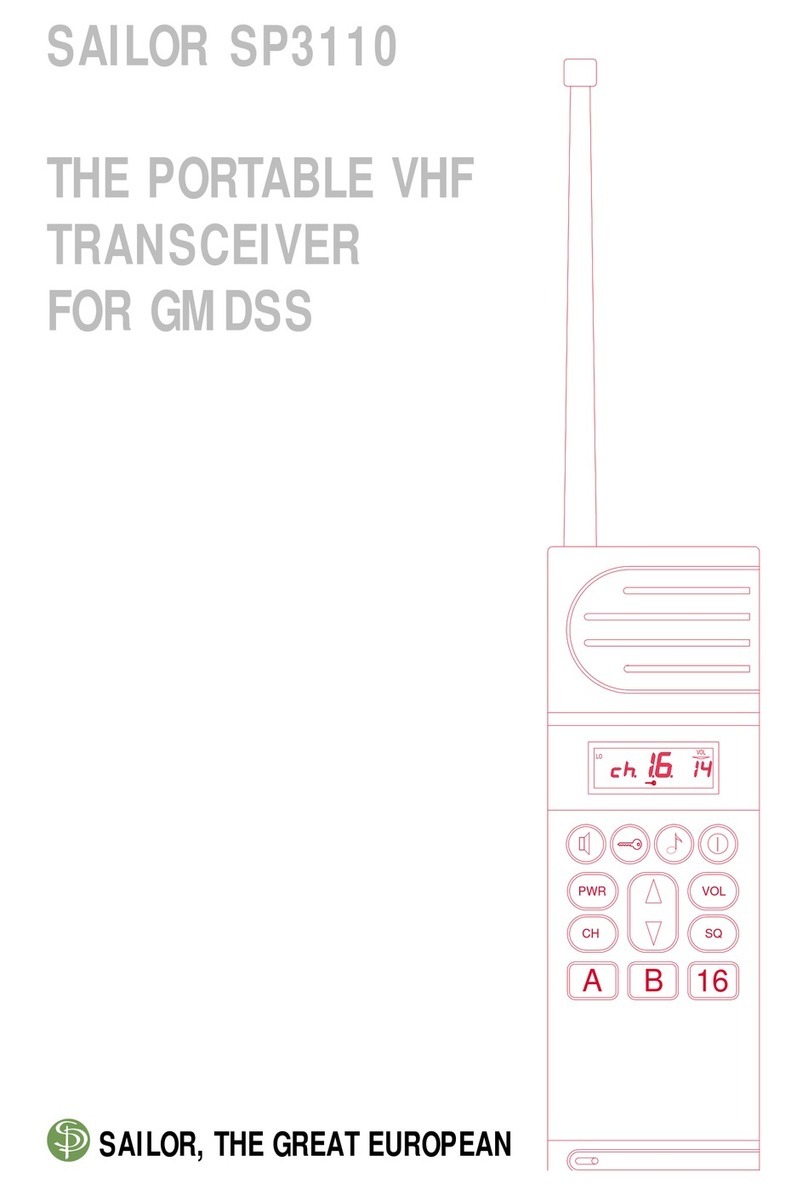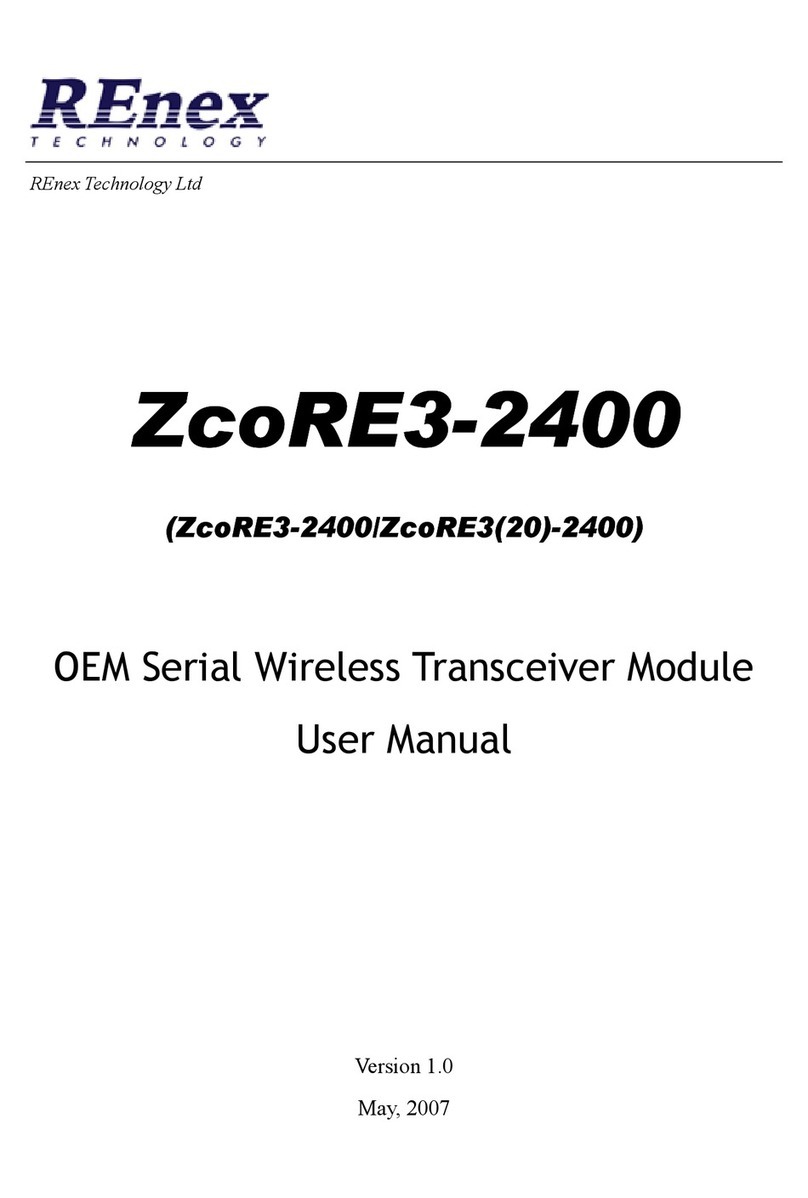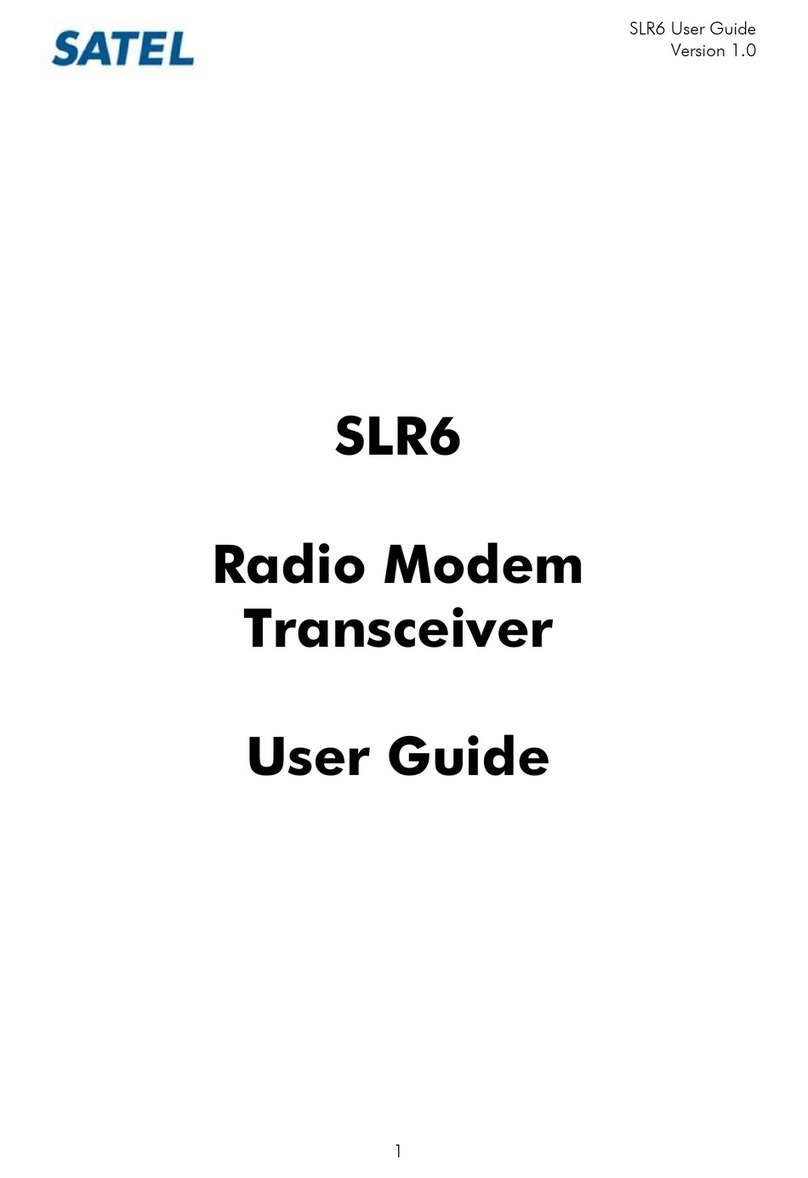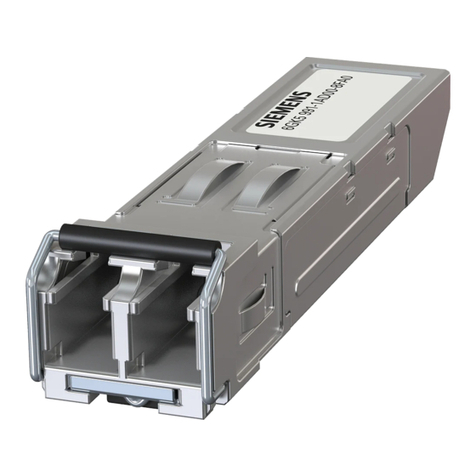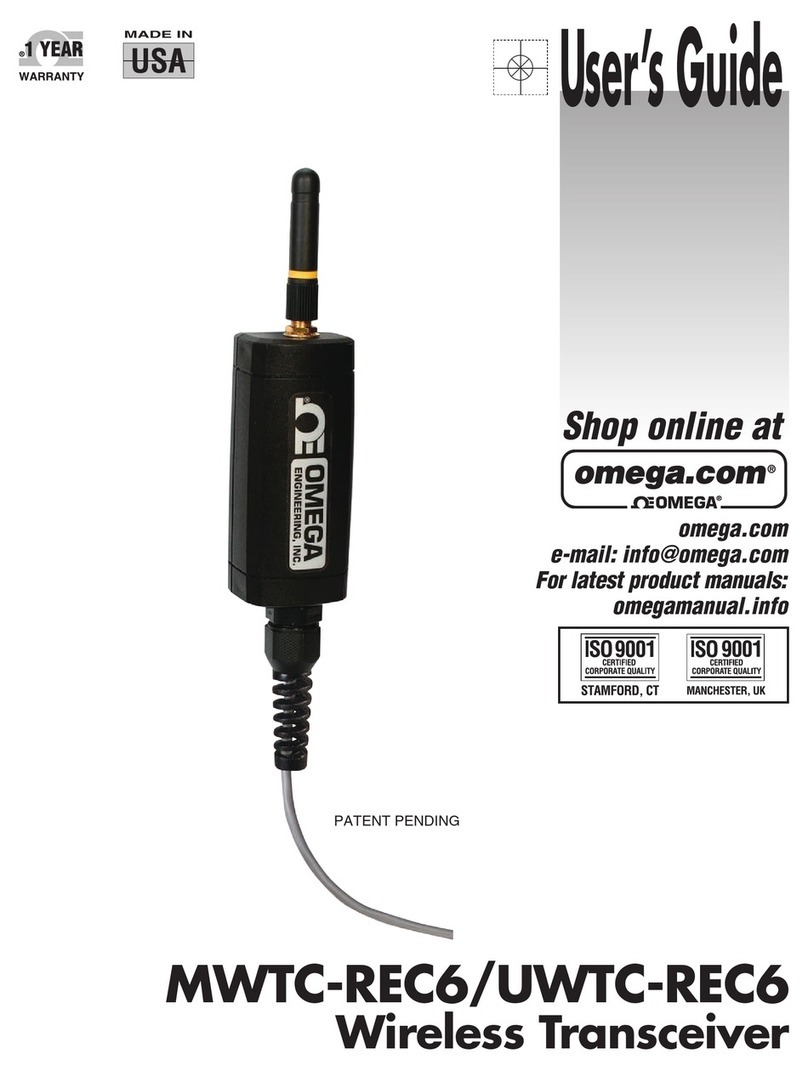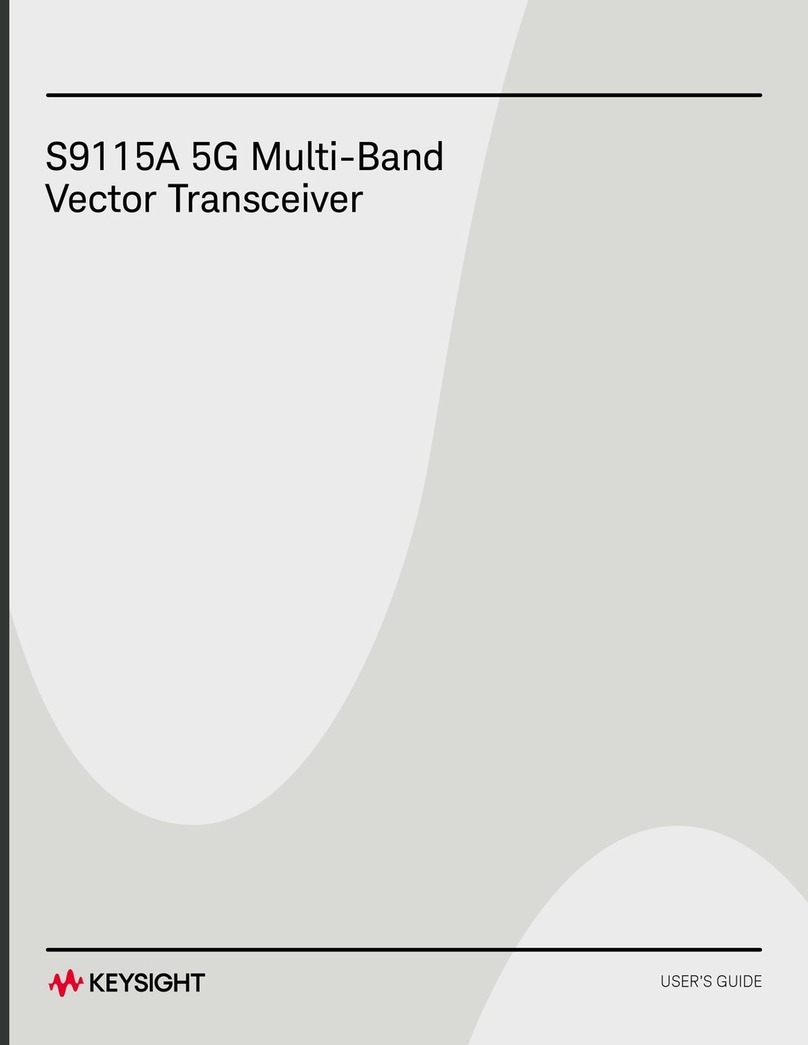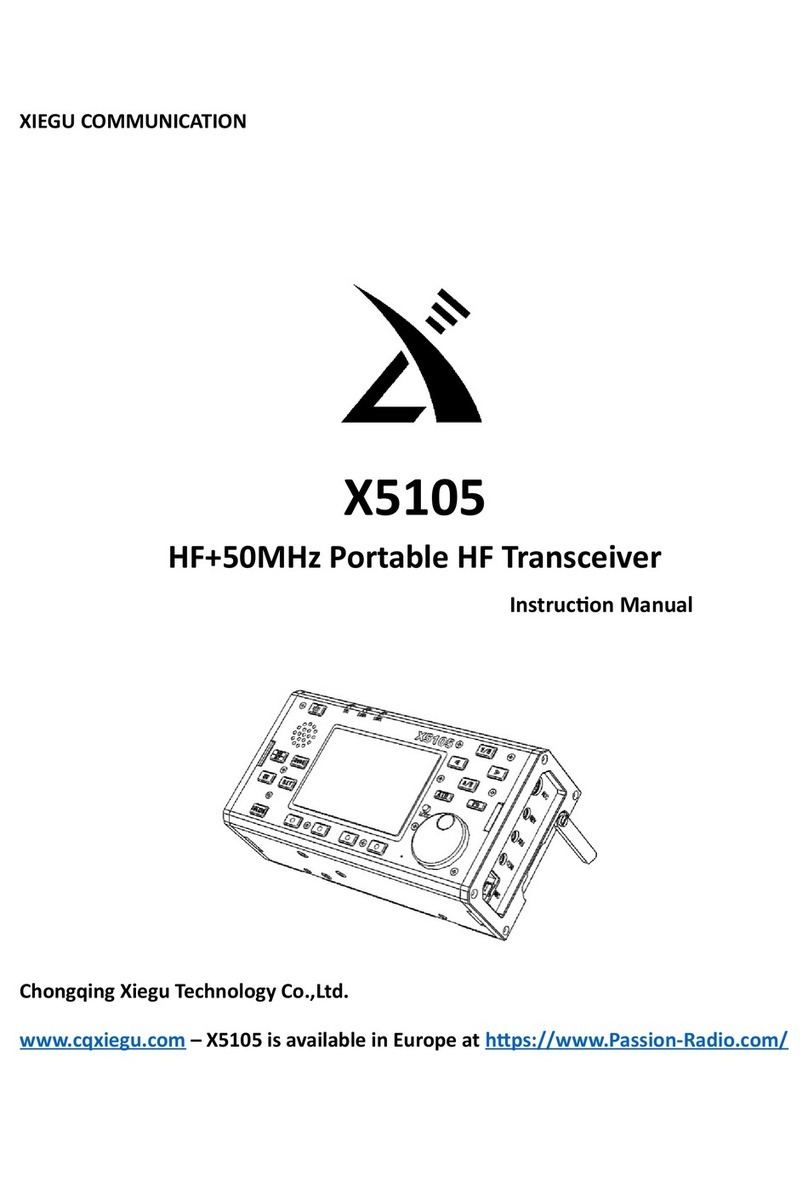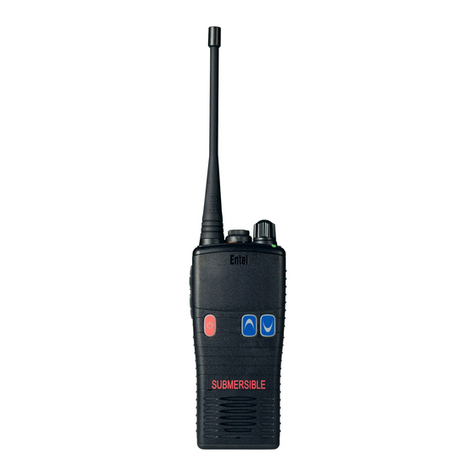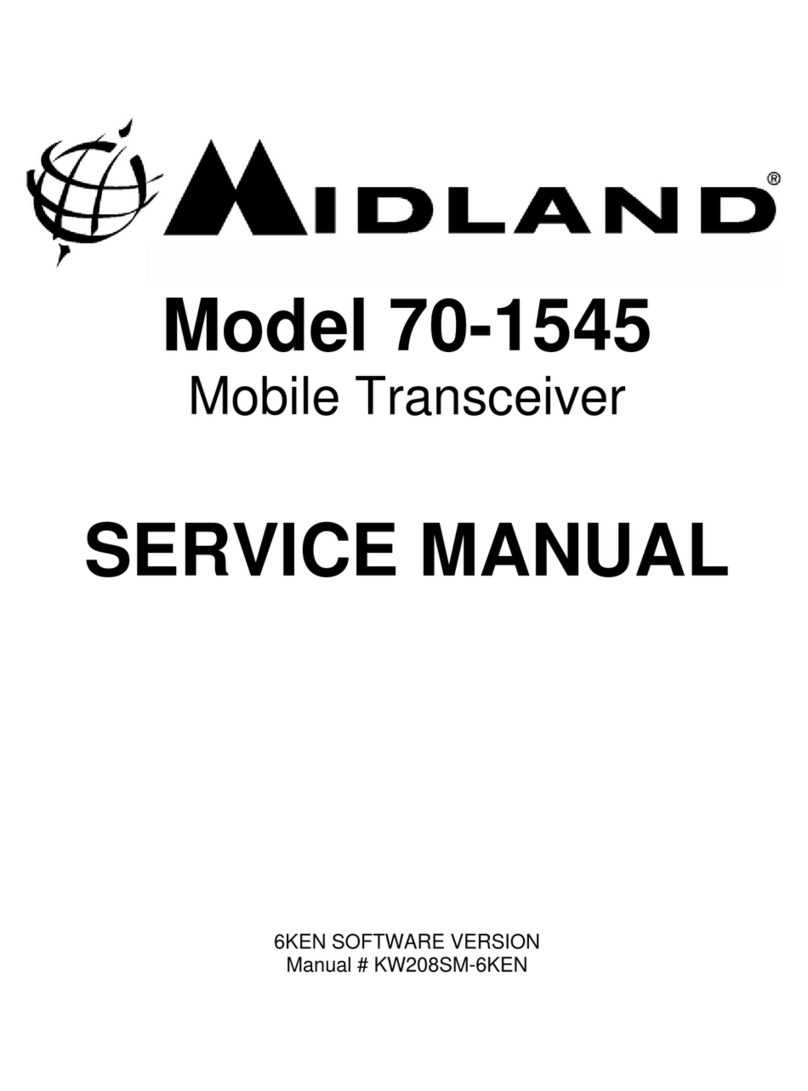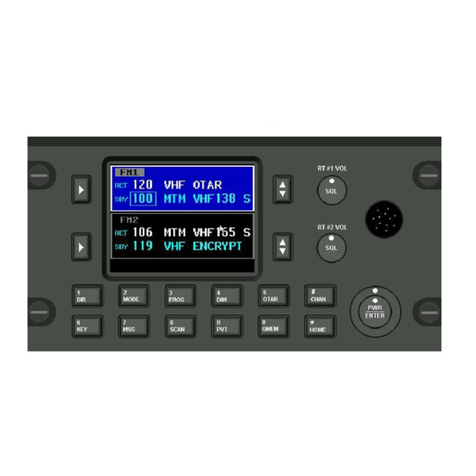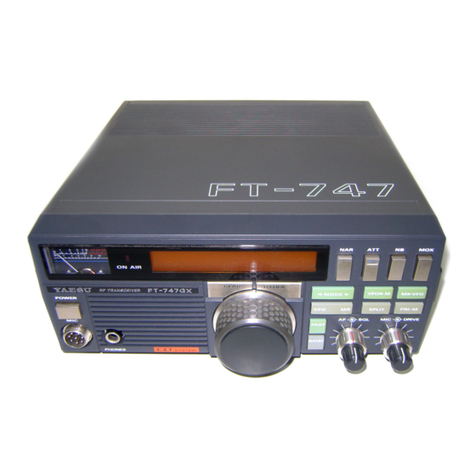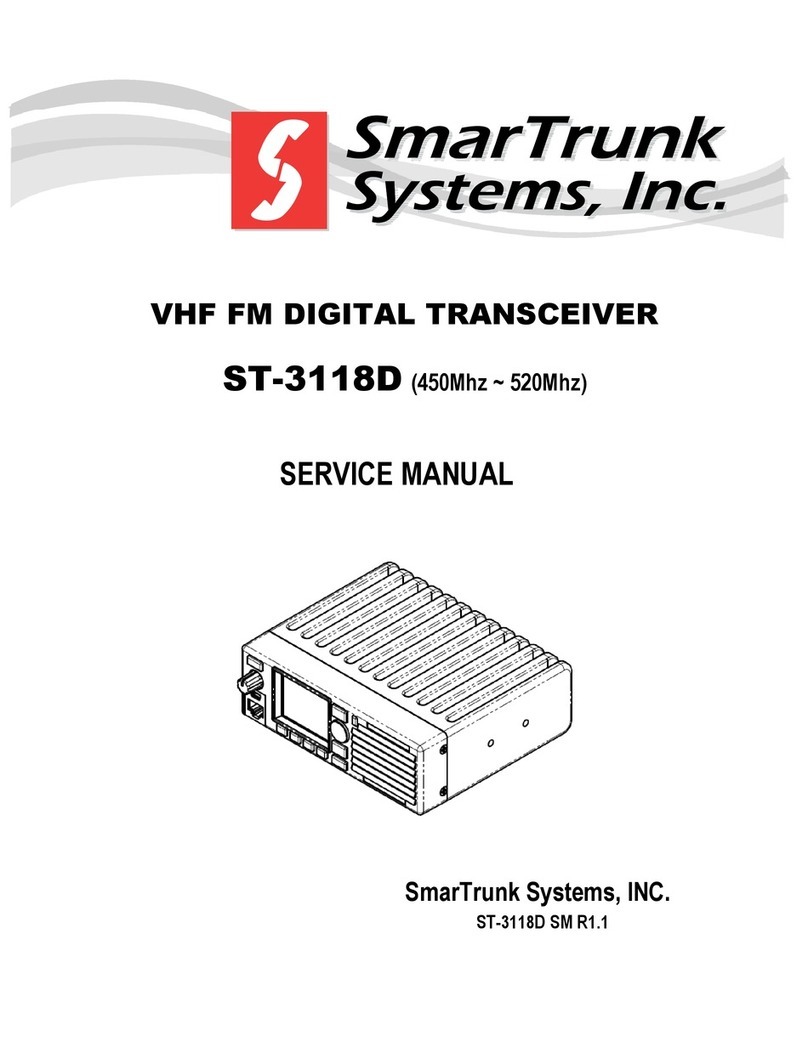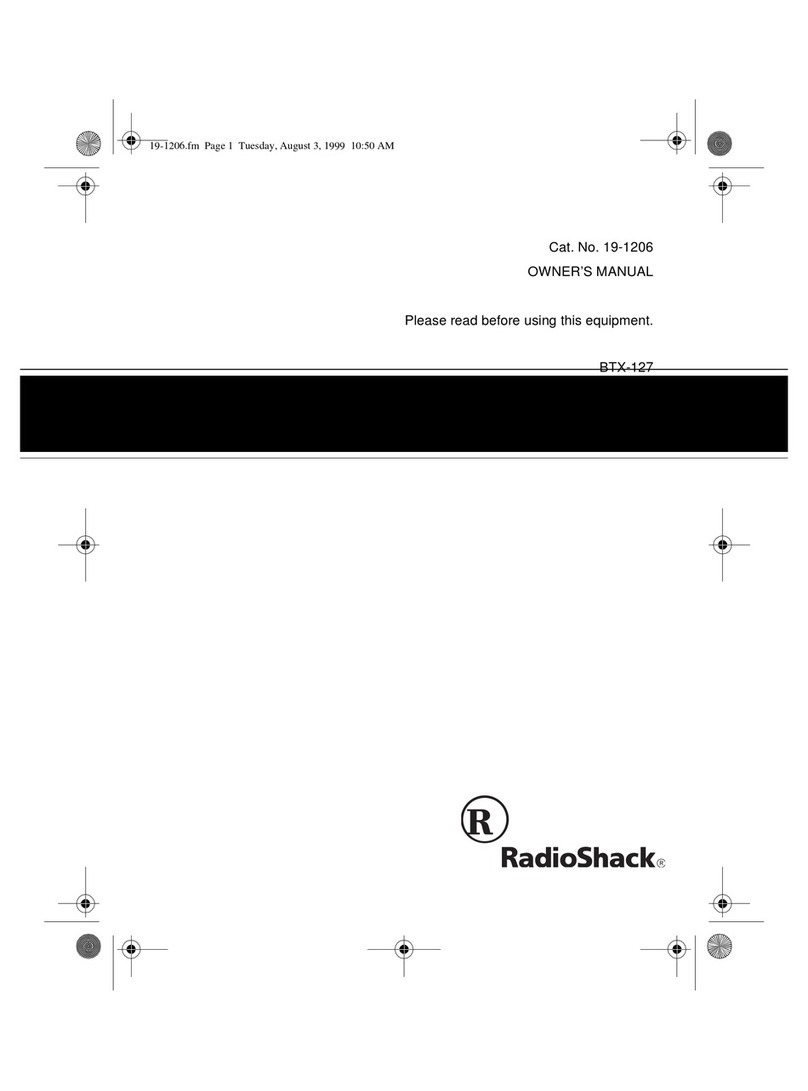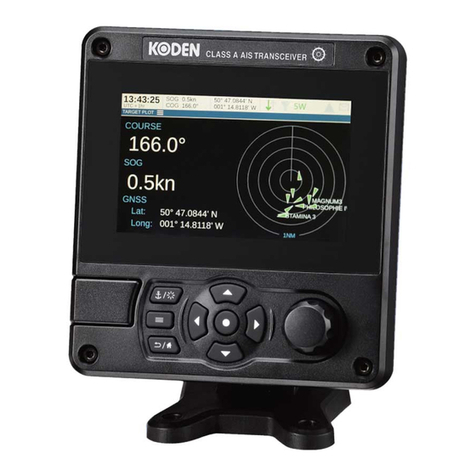Icom IC-M33 User manual

INSTRUCTION MANUAL
iM33
VHF MARINE TRANSCEIVER

i
DECLARATION
OF CONFORMITY
We Icom Inc. Japan
1-1-32, Kamiminami, Hirano-ku
Osaka 547-0003, Japan
Kind of equipment:
VHF MARINE TRANSCEIVER
This compliance is based on conformity with the following harmonised
standards, specifications or documents:
i) EN 301 178-2 V1.1.1 (2000-8)
ii) EN 60945 2002
iii) EN 60950-1 2001
iv) EN 300 698-2 V1.1.1 (2000-8)
v) EN 300 698-3 V1.1.1 (2001-5)
vi)
vii)
Type-designation: iM33
Signature
H. Ikegami
General Manager
Düsseldorf 30th Nov. 2006
Himmelgeister straße 100
D-40225 Düsseldorf
Icom (Europe) GmbH
Authorized representative name
Place and date of issue
Version (where applicable):
Declare on our sole responsability that this equipment complies the
essential requirements of the Radio and Telecommunications Terminal
Equipment Directive, 1999/5/EC, and that any applicable Essential Test
Suite measurements have been performed.
0560
CE Versions of the IC-M33 which display the
“CE” symbol on the serial number seal, comply
with the essential requirements of the Euro-
pean Radio and Telecommunication Terminal
Directive 1999/5/EC.
This warning symbol indicates that this equipment
operates in non-harmonised frequency bands
and/or may be subject to licensing conditions in
the country of use. Be sure to check that you have
the correct version of this radio or the correct pro-
gramming of this radio, to comply with national li-
censing requirement.

ii
IN CASE OF EMERGENCY
If your vessel requires assistance, contact other vessels and
the Coast Guard by sending a distress call on Channel 16.
❍USING CHANNEL 16
DISTRESS CALL PROCEDURE
1. “MAYDAY MAYDAY MAYDAY.”
2. “THIS IS ...........................” (name of vessel)
3. Your call sign or other indication of the ves-
sel.
4. “LOCATED AT .....................” (your position)
5. The nature of the distress and assistance re-
quired.
6. Any other information which might facilitate
the rescue.
RECOMMENDATION
CLEAN THE TRANSCEIVER THOROUGHLY WITH FRESH
WATER after exposure to saltwater, and dry it before opera-
tion. Otherwise, the transceiver's keys, switches and con-
trollers may become unusable due to salt crystallization.
NOTE: DO NOT wash the transceiver in water if there is any
reason to suspect the waterproofing may not be effective. For
example, in cases where the battery pack rubber seal is dam-
aged, the transceiver/battery pack is cracked or broken, or
has been dropped, or when the battery pack is detached from
the transceiver.

FOREWORD
Thank you for purchasing this Icom radio. The IC-M33
VHF MA
-
RINE TRANSCEIVER
is designed and built with Icom’s state of the
art technology and craftsmanship. With proper care this radio
should provide you with years of trouble-free operation.
IMPORTANT
READ ALL INSTRUCTIONS carefully and com-
pletely before using the transceiver.
SAVE THIS INSTRUCTION MANUAL—This in-
struction manual contains important operating instructions for
the IC-M33.
EXPLICIT DEFINITIONS
FEATURES
☞Submersible construction
Built tough to withstand the punishing marine environ-
ment, the IC-M33’s submersible construction meets IPX7
of the corresponding International Standard IEC 60529
(2001) while using BP-251 (option) or BP-252.
☞Floating on water
The IC-M33 floats on fresh or salt
water even when the supplied acces-
sories are attached.
• When third-party battery pack, strap, an-
tenna, etc. is used, it may sink.
• The battery contacts may be prone to rust-
ing if the transceiver is kept floating in
fresh or salt water.
☞Large, easy-to-read LCD
With dimensions of 16(H) ×32(W) mm, the IC-M33’s func-
tion display is easy to read and shows operating condi-
tions at a glance. Backlighting and contrast can be
adjusted to suit your preferences.
☞Simple operation
9 large buttons on the front panel provide user-friendly op-
eration. The independent volume and channel buttons are
located on the front panel for convenient one-hand opera-
tion.
DEFINITION
RWARNING
CAUTION
NOTE
Personal injury, fire hazard or electric shock
may occur.
If disregarded, inconvenience only. No risk
of personal injury, fire or electric shock.
Equipment damage may occur.
WORD
iii

iv
PRECAUTIONS
RWARNING! NEVER connect the transceiver to an
AC outlet. This may pose a fire hazard or result in an electric
shock.
RWARNING! NEVER hold the transceiver so that the
antenna is closer than 2.5 cm from exposed parts of the body,
especially the face or eyes, while transmitting. The trans-
ceiver will perform best if the microphone is 5 to 10 cm away
from the lips and the transceiver is vertical.
NEVER connect the transceiver to a power source other
than the BP-251 (option) or BP-252. Such a connection will
ruin the transceiver.
AVOID using or placing the transceiver in direct sunlight or
in areas with temperatures below –15°C or above +55°C.
KEEP the transceiver out of the reach of children.
KEEP the transceiver at least 0.9 meters away from your
vessel’s magnetic navigation compass.
BE CAREFUL! The transceiver’s right-side panel will
become hot when operating continuously for long periods.
BE CAREFUL! The transceiver employs waterproof
construction, which corresponds to IPX7 of the international
standard IEC 60529 (2001). However, once the transceiver
has been dropped, waterproofing cannot be guaranteed due
to the fact that the transceiver may be cracked, or the water-
proof seal damaged, etc.
MAKE SURE the flexible antenna and battery pack are
securely attached to the transceiver, and that the antenna and
battery pack are dry before attachment. Exposing the inside
of the transceiver to water will result in serious damage to the
transceiver.
After exposure to water, clean the battery contacts thoroughly
with fresh water and dry them completely to remove any
water or salt residue.
Icom, Icom Inc. and the logo are registered trademarks of Icom Incor-
porated (Japan) in the United States, the United Kingdom, Germany, France,
Spain, Russia and/or other countries.

v
DOC ........................................................................................... i
IN CASE OF EMERGENCY ..................................................... ii
RECOMMENDATION ............................................................... ii
FOREWORD ............................................................................ iii
IMPORTANT ............................................................................ iii
EXPLICIT DEFINITIONS .......................................................... iii
FEATURES .............................................................................. iii
PRECAUTIONS ....................................................................... iv
TABLE OF CONTENTS ............................................................ v
1 OPERATING RULES ......................................................... 1
2 SUPPLIED ACCESSORIES AND ATTACHMENTS ....... 2–3
■Supplied accessories ....................................................... 2
■Attachments ..................................................................... 2
3 PANEL DESCRIPTION .................................................. 4–7
■Front, top and side panels ............................................... 4
■Function display .............................................................. 6
4 BASIC OPERATION .................................................... 8–13
■Channel selection ........................................................... 8
■Receiving and transmitting ............................................ 10
■Call channel programming ............................................ 11
■Adjusting the volume level ............................................. 11
■Volume mute function .................................................... 11
■Adjusting the squelch level ........................................... 12
■Lock function ................................................................. 12
■Automatic backlighting .................................................. 12
■Monitor function ............................................................ 13
■AquaQuake water draining function .............................. 13
5 SCAN OPERATION (Except Holland version) ........ 14–15
■Scan types .................................................................... 14
■Setting TAG channels ................................................... 15
■Starting a scan .............................................................. 15
6 DUALWATCH/TRI-WATCH (Except Holland version) ... 16
■Description .................................................................... 16
■Operation ...................................................................... 16
7 SET MODE ................................................................. 17–20
■Set mode programming ................................................ 17
■Set mode items ............................................................. 18
8 BATTERY CHARGING ............................................... 21–24
■Battery caution .............................................................. 21
■Supplied battery charger ............................................... 23
■Optional battery case ..................................................... 23
■Optional battery charger ............................................... 24
9 OPTIONAL SPEAKER-MICROPHONE ........................... 25
■HM-165 descriptions ..................................................... 25
■Attachment .................................................................... 25
10 TROUBLESHOOTING ..................................................... 26
11 VHF MARINE CHANNEL LIST ........................................ 27
12 SPECIFICATIONS............................................................. 28
13 OPTIONS .......................................................................... 29
TABLE OF CONTENTS

1
1
OPERATING RULES
1
DPriorities
• Read all rules and regulations pertaining to priorities and
keep an up-to-date copy handy. Safety and distress calls
take priority over all others.
• You must monitor Channel 16 when you are not operating
on another channel.
• False or fraudulent distress calls are prohibited under law.
DPrivacy
• Information overheard but not intended for you cannot law-
fully be used in any way.
• Indecent or profane language is prohibited.
DRadio licenses
(1) SHIP STATION LICENSE
When your craft is equipped with a VHF FM transceiver, you
must have a current radio station license before using the
transceiver. It is unlawful to operate a ship station which is not
licensed.
Inquire through your dealer or the appropriate government
agency for a Ship-Radiotelephone license. This license in-
cludes the call sign which is your craft’s identification for radio
purposes.
(2) OPERATOR’S LICENSE
A restricted Radiotelephone Operator Permit is the license
most often held by small vessel radio operators when a radio
is not required for safety purposes.
The Restricted Radiotelephone Operator Permit must be
posted near the transceiver or be kept with the operator. Only
a licensed radio operator may operate a transceiver.
However, non-licensed individuals may talk over a transceiver
if a licensed operator starts, supervises, ends the call and
makes the necessary log entries.
A current copy of the applicable government rules and regu-
lations is only required to be on hand for vessels in which a
radio telephone is compulsory. However, even if you are not
required to have these on hand it is your responsibility to be
thoroughly acquainted with all pertinent rules and regulations.

2
SUPPLIED ACCESSORIES AND ATTACHMENTS
2
■Supplied accessories
■Attachments
DFlexible antenna
Connect the supplied flexible an-
tenna to the antenna connector.
CAUTION!
• NEVER carry the transceiver
by the antenna.
• Transmitting without an an-
tenna may damage the trans-
ceiver.
Battery packHandstrap
Belt clip
Battery charger
(with 2 screws)
Antenna
AC adapter
(Not supplied with
some version)
DHandstrap
Pass the handstrap through
the loop on the side of the
transceiver as illustrated at
right. This facilitates carry-
ing.
DBelt clip
Attach/detach the belt clip to the transceiver as illustrated
below.
To attach the belt clip To detach the belt clip
wBe careful!
Not to break
your nails.
q

3
2
SUPPLIED ACCESSORIES AND ATTACHMENTS
2
ïBattery pack
To remove the battery pack:
Turn the screw counterclockwise one quarter turn, then pull
the battery pack in the direction of the arrow as shown below.
To attach the battery pack:
Insert the battery pack in the IC-M33 completely, then turn the
screw clockwise one quarter turn.
NEVER remove or insert the battery pack when the trans-
ceiver is wet or soiled. This may result water or dust get-
ting into the transceiver/battery pack and may result in the
transceiver being damaged.
NOTE: When removing or attaching the battery pack, use
a coin or standard screwdriver to loosen or tighten the bot-
tom screw.
CAUTION!:
When attaching or removing a battery pack, make sure the
rubber seal is set in the groove of the battery pack cor-
rectly. If the seal is not neatly in the groove it may be dam-
aged when attaching the battery pack.
If the seal is damaged, waterproofing is not guaranteed.
Screw position
when removing battery
Screw position
when attaching battery
Make sure the rubber seal (purple) is properly seated in the
groove and dust or other material does not adhere to it.
Battery pack Battery pack
Rubber seal
Groove
Correct position Incorrect position
NOTE:
When attaching a battery pack, make sure dust or other
material does not adhere to the rubber seal. If dust or other
material is on the seal when attaching a battery pack, water
resistance may be compromised.

4
PANEL DESCRIPTION
3
■Front, top and side panels
qPOWER SWITCH [PWR]
Push and hold to turn power ON and OFF.
wSPEAKER-MICROPHONE CONNECTOR [SP MIC] (p. 25)
Connects the optional external speaker-microphone.
NOTE: Attach the [SP MIC] cap when the optional
speaker-microphone is not used. Otherwise, water will
get into the transceiver.
eANTENNA CONNECTOR (p. 2)
Connects the supplied antenna.
rCHANNEL KEY [CH]
➥Selects the regular channel when pushed. (p. 9)
➥Selects the U.S.A.,* International or ATIS†channel group
when pushed and held for 1 sec. (p. 9)
➥Push to return to the previous channel before selecting
channel 16 or the call channel.
*U.K. version only; †German and Holland versions only
qAttach the
[SP MIC]
cap.
wThen rotate it clockwise
completely.
w
q
Microphone Function display
(pgs. 6, 7)
Speaker
o
!2
!1
!0
i
t
y
u
r
w
qe

5
3
PANEL DESCRIPTION
3
tFAVORITE/TAG KEY [FAV•TAG]
➥While pushing and holding this key, push [Y]/[Z] to se-
lect the favorite (TAG) channels with ignoring untagged
channels in the selected channel group in sequence.
(p. 8)
•Pushing this key only advances the displayed TAG channel.
➥Push and hold for 1 sec. to set or clear the displayed
channel as a TAG (scanned) channel. (p. 15)
➥While pushing and holding this key, turn power ON to
clear or set all TAG channels (when no TAG channel has
been set) in the selected channel group. (p. 15)
ySQUELCH/MONITOR KEY [SQL•MONI]
➥Push this key, then adjust the squelch level with [Y]/[Z].
(p. 12)
➥Manually opens the squelch for monitoring the channel
while pushing and holding. (p. 13)
➥While pushing and holding this key, turn power ON to
enter the set mode. (p. 17)
uTRANSMIT POWER/LOCK KEY [H/L•LOCK]
➥Selects high or low power when pushed. (p. 10)
➥Toggles between the key lock function ON/OFF when
pushed and held for 1 sec. (p. 12)
iCHANNEL UP/DOWN KEYS [YY]/[ZZ]
➥Selects an operating channel. (pgs. 8, 9)
➥Selects the set mode setting of the item. (p. 17)
➥Checks TAG channels or changes scanning direction
during scan. (p. 15)
oSCAN/DUAL KEY [SCAN•DUAL]
➥Push to start or stop normal or priority scan. (p. 15)
➥Push and hold for 1 sec. to enter watch mode. (p. 16)
➥Push and hold this key and [H/L], to activate the
AquaQuake function. (p. 13)
➥Exits watch mode when pushed during watch operation.
(p. 16)
!0 VOLUME KEY [VOL•MUTE]
➥Push this key, then adjust the volume level with [Y]/[Z].
(p. 11)
➥Push and hold for 1 sec. to activate the volume mute
function. (p. 11)
!1 CHANNEL 16 KEY [16•C]
➥Push to select Channel 16. (p. 8)
➥Push and hold for 1 sec. to select the call channel. (p. 8)
➥Enters call channel programming condition when the call
channel is selected and this key is pushed and held for 3
sec. (p. 11)
➥Push to exit set mode during set mode operation. (p. 17)
!2 PTT SWITCH [PTT]
Push and hold to transmit; release to receive. (p. 10)

6
3PANEL DESCRIPTION
■Function display
qTRANSMIT INDICATOR (p. 10)
Appears while transmitting.
wBUSY INDICATOR
➥Appears when receiving a signal or when the squelch
opens. (p. 10)
➥Blinks while monitoring. (p. 13)
eTAG CHANNEL INDICATOR (p. 15)
Appears when a TAG channel is selected.
rCALL CHANNEL INDICATOR (p. 8)
Appears when the call channel is selected.
tLOCK INDICATOR (p. 12)
Appears while the lock function is activated.
yBATTERY INDICATOR
Indicates remaining battery power.
uSCAN INDICATOR (p. 15)
Blinks while scanning.
iDUALWATCH/TRI-WATCH INDICATORS (p. 16)
“DUAL”appears during dualwatch; “TRI”appears during
tri-watch.
oDUPLEX INDICATOR
Appears when a duplex channel is selected.
!0 SUB CHANNEL READOUT
➥Indicates Channel 16 during priority scan, dualwatch or
tri-watch. (p. 16)
➥Indicates the set mode item while in set mode. (p. 17)
➥Indicates the squelch level while squelch setting. (p. 12)
➥Indicates the volume level while volume setting. (p. 11)
Indication
Full Middle Charging
required No battery
Battery level
blinks when the battery is exhausted.
blinks when the battery is over charged.
!5 !3!4
i
u
o
!2
!1
!0
!8
!6
qer ytw
!7

7
3
PANEL DESCRIPTION
3
!1 SQUELCH LEVEL INDICATOR
Shows the squelch level.
!2 VOLUME LEVEL INDICATOR
➥Shows the volume level.
➥Blinks when the volume mute is activated. (p. 11)
!3 VOLUME LEVEL ADJUSTING INDICATOR (p. 11)
Blinks while adjusting the volume level.
!4 SQUELCH LEVEL ADJUSTING INDICATOR (p. 12)
Blinks while adjusting the squelch level.
!5 CHANNEL NUMBER READOUT
➥Indicates the selected operating channel number.
➥In set mode, indicates the selected condition.
!6 CHANNEL GROUP INDICATOR (p. 9)
“UU”appears when U.S.A.*; “”appears when Interna-
tional.
*U.K. version only
!7 ATIS INDICATORS (p. 9)
➥“ATIS”appears when the channel group, which ATIS
function is activated, is selected. (Available with German
and Holland versions only)
!8 LOW POWER INDICATOR (p. 10)
➥“LOW”appears when low power is selected.
➥“LOW”blinks when switching forced low power mode
because of a high temperature error or low voltage.

8
BASIC OPERATION
4
■Channel selection
IMPORTANT!: Prior to using the transceiver for the first
time, the battery pack must be fully charged for optimum
life and operation. To avoid damage to the transceiver, turn
the power OFF while charging.
DChannel 16
Channel 16 is the distress and safety channel. It used for es-
tablishing initial contact with a station and for emergency
communications. Channel 16 is monitored during both Dual-
watch and Tri-watch. While standing by, you must monitor
Channel 16.
qPush [16] momentarily to select Channel 16.
wPush [CH] to return to the channel used before Channel
16, or push [YY]/[ZZ]to select a channel.
Convenient!
While pushing and holding [FAV], push [Y]/[Z] to select the
favorite (TAG) channels with ignoring untagged channels in
the selected channel group in sequence.
•Pushing [FAV] only advances the displayed TAG channel.
•The favorite channels are selected using the TAG channel setting.
(p. 15)
DCall channel
Each regular channel group has separate leisure-use call
channels. The call channel is monitored during Tri-watch. The
call channels can be programmed (p. 11) and are used to
store your most often used channel in each channel group for
quick recall.
qPush and hold [C] (16) for 1 sec. to select the call channel
of the selected channel group.
•“CALL”and call channel number appear.
•Each channel group may have an independent call channel after
programming a call channel. (p. 11)
wPush [CH] to return to the channel used before call chan-
nel, or push [YY]/[ZZ]to select a channel.
Push and hold
for 1 sec.
Push

9
4
BASIC OPERATION
4
DU.S.A., International and ATIS channels
The IC-M33 is pre-programmed with U.S.A.*, International
and ATIS†channels. These channel groups may be specified
for the operating area.
*U.K. version only; †German and Holland versions only
qPush [CH] to select a regular channel.
wPush and hold [CH] for 1 sec. to change the channel
group. Repeat to advance to the next group.
•U.S.A., International and ATIS channel groups can be selected in
sequence.
ePush [YY]/[ZZ]to select a channel.
•“DUP”appears for duplex channels.
Push and hold
for 1 sec.
U.S.A. channels
International channels
ATIS channels

10
4BASIC OPERATION
■Receiving and transmitting
CAUTION: Transmitting without an antenna will damage
the transceiver.
qPush and hold [PWR] to turn power ON.
wSet the audio and squelch levels.
➥Push [SQL], and push [ZZ]several times to open the squelch.
➥Push [VOL], then push [YY]/[ZZ]to adjust the volume level.
➥Push [SQL], and push [YY]until the noise disappears.
ePush [YY]/[ZZ]to select the desired channel.
•When receiving a signal, “”appears and audio is emitted
from the speaker.
•Further adjustment of the audio may be necessary at this point.
rPush [H/L] to select the output power if necessary.
•“LOW”appears when low power is selected; no indication when
high power is selected.
•Choose low power to conserve battery power, choose high
power for longer distance communications.
•Some channels are for low power only.
tPush and hold [PTT] to transmit, then speak into the
microphone.
•“”appears.
•Channel 70 cannot be used for transmission.
yRelease [PTT] to receive.
IMPORTANT: To maximize the readability of your trans-
mitted signal, pause a few sec. after pushing [PTT], hold
the microphone 5 to 10 cm from your mouth and speak
into the microphone at a normal voice level.
NOTE: The transceiver has a power save function to con-
serve the battery power. The power save function activates
automatically when no signal is received for 5 sec.
Microphone
rSet output
power
qPower ON
wSet the
squelch level
wSet volume
tPush to
transmit
yRelease to
receive
eSet channel
Set the squelch
and volume level.
w

11
4
BASIC OPERATION
4
■Call channel programming
Call channel is used to access Channel 16 (default; may differ
according to version), however, you can program the call chan-
nel with your most often-used channels in each channel
group for quick recall.
qPush and hold [CH] for 1 sec. several times to select the
desired channel group (U.S.A., International or ATIS) to be
programmed. (p. 9)
wPush and hold [C] (16) for 1 sec. to select the call channel
of the selected channel group.
•“CALL”and call channel number appear.
ePush and hold [C] (16) again for 3
sec. (until a long beep changes to
2 short beeps) to begin call chan-
nel programming.
•Channel number starts blinking.
rPush [YY]/[ZZ]to select the desired
channel.
tPush [16] to program the dis-
played channel as the call chan-
nel.
•The channel number stops blinking.
■Adjusting the volume level
The volume level can be adjusted with [VOL] and [YY]/[ZZ].
qPush [VOL], then adjust the volume level with [YY]/[ZZ].
•“VOL”indicator starts blinking.
•There are 31 volume levels and OFF.
•When no key is pushed for 5 sec., the transceiver returns to nor-
mal condition.
wPush [VOL] again to return to normal condition.
■Volume mute function
The volume mute function can be activated temporarily with
[MUTE] (VOL).
qPush and hold [MUTE] (VOL) for 1 sec to activate the vol-
ume mute function.
•The audio is muted.
•The volume level indicator starts blinking.
wPush [VOL] again or turn power OFF to turn the volume
mute function OFF.
Indicates the
volume level.
Blinks during volume level adjustment.

12
4BASIC OPERATION
■Adjusting the squelch level
To adjust the IC-M33’s squelch level, use the [YY]/[ZZ]keys as
described below. In order to receive signals properly, as well
as for the scan to function effectively, the squelch must be ad-
justed to the proper level.
qPush [SQL], then adjust the squelch level with [YY]/[ZZ].
•“SQL”indicator starts blinking.
•There are 11 squelch levels to choose from: OP is completely
open; 10 is tight squelch; 1 is loose squelch.
•If no key is pushed for 5 sec., the transceiver returns to normal
operation.
wPush [SQL] again to return to normal condition.
■Lock function
This function electronically locks all keys (except for [PTT],
[SQL•MONI], [VOL•MUTE], [H/L•LOCK] and [YY]/[ZZ]*) to
prevent accidental channel changes and function access.
* After pushing [VOL•MUTE] or [SQL•MONI] only.
➥Push and hold [LOCK] (H/L) for 1 sec. to turn the lock
function ON and OFF.
■Automatic backlighting
This function is convenient for nighttime operation. The auto-
matic backlighting can be activated in set mode. (p. 19)
➥Push any key except for [PTT] to turn the backlighting ON.
•The backlighting is automatically turned OFF after 5 sec. of in-
activity.
Push and hold
for 1 sec.
Appears while the lock
function is used.
Blinks during squelch
level adjustment.
Indicates the
squelch level.

13
4
BASIC OPERATION
4
■Monitor function
The monitor function opens the squelch. See p. 5 for details
of the monitor key action.
➥The monitor function activates while pushing and holding
[MONI] (SQL).
•“ ”blinks and audio is emitted.
■
AquaQuake water draining function
The IC-M33 uses a new technology to clear water away from
the speaker grill: AquaQuake. AquaQuake helps drain water
away from the speaker housing (water that might otherwise
muffle the sound coming from the speaker). The IC-M33
emits a vibrating beep when this function is being used.
➥Push and hold both [SCAN] and [H/L].
•A low beep tone sounds for 9 sec. to drain water, regardless of
volume level setting.
•The transceiver does not perform key operations while the
AquaQuake function is activated. The AquaQuake function can not
be activated when an optional speaker-microphone is connected.
Push and hold
Blinks while the monitor function is used.

14
SCAN OPERATION (Except Holland version)
5
■Scan types
Scanning is an efficient way to locate signals quickly over a
wide frequency range. The transceiver has priority scan and
normal scan.
In addition, auto scan function is available for standby conve-
nience. This function can be activated depending on the set-
ting in set mode. (p. 18)
Set the TAG channels (scanned channels) before scanning.
Clear any TAG channels which inconveniently stop scanning,
such as digital communications.
Choose priority or normal scan in set mode. (p. 18)
PRIORITY SCAN
Priority scan searches through all TAG channels in se-
quence while monitoring Channel 16. When a signal is de-
tected on Channel 16, scan pauses until the signal disap-
pears; when a signal is detected on a channel other than
Channel 16, scan becomes dualwatch until the signal dis-
appears.
CH 88
CH 01
CH 16
CH 02
CH 05 CH 04
CH 03
NORMAL SCAN
Normal scan, like priority scan, searches through all TAG
channels in sequence. However, unlike priority scan, Chan-
nel 16 is not checked unless Channel 16 is set as a TAG
channel.
CH 01 CH 02
CH 88
CH 05 CH 04
CH 03
Other manuals for IC-M33
1
Table of contents
Other Icom Transceiver manuals
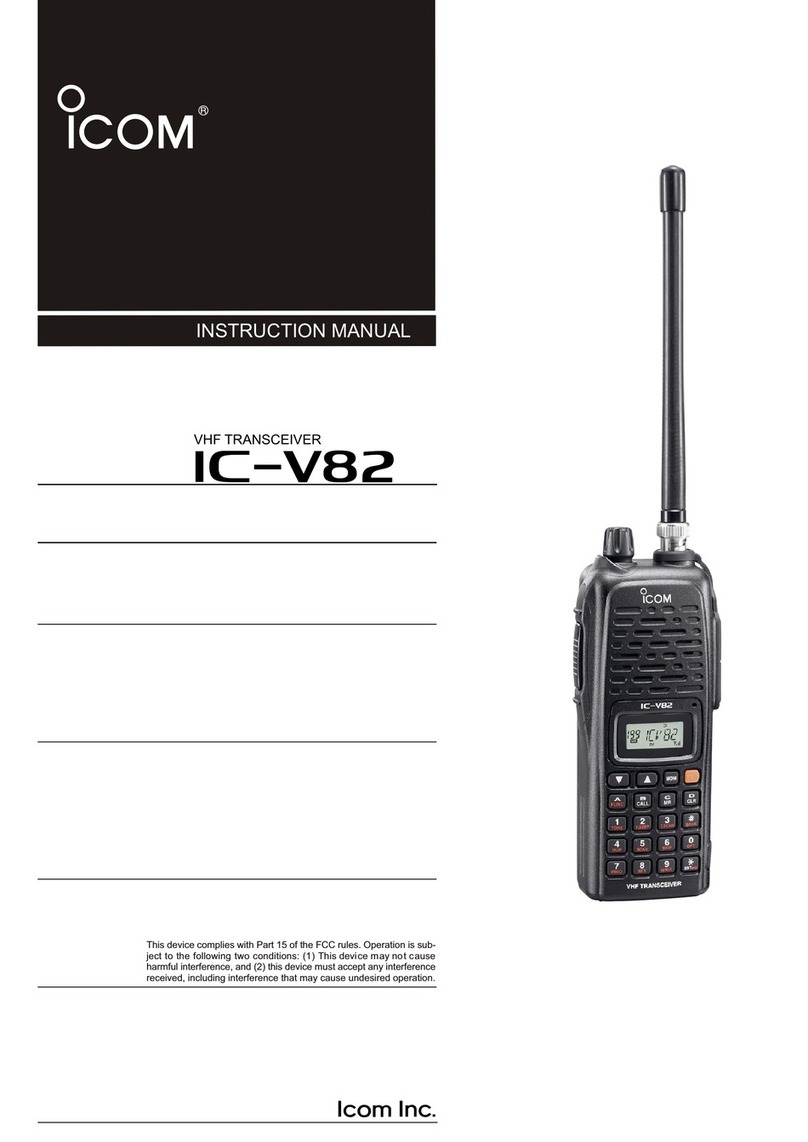
Icom
Icom IC-V82 User manual
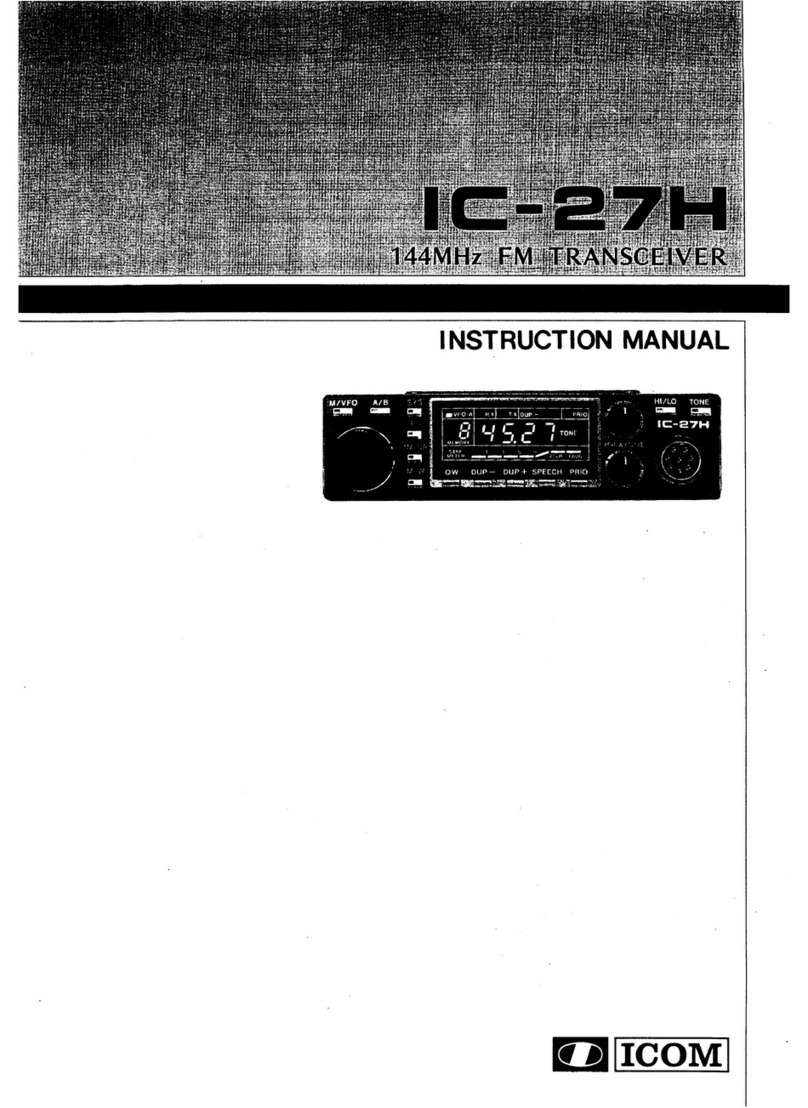
Icom
Icom IC-27H User manual
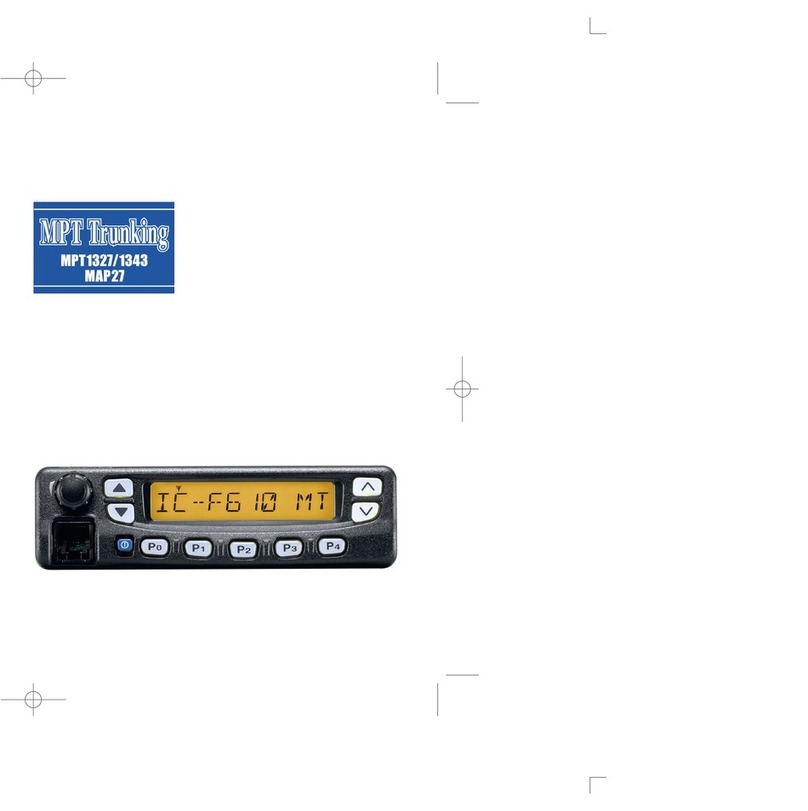
Icom
Icom IC-F610 User manual
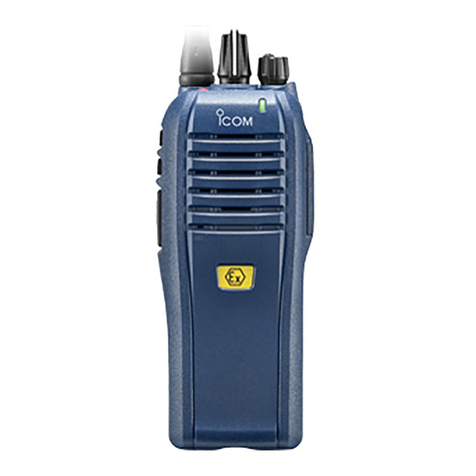
Icom
Icom IDAS F3201DEX 14 User manual
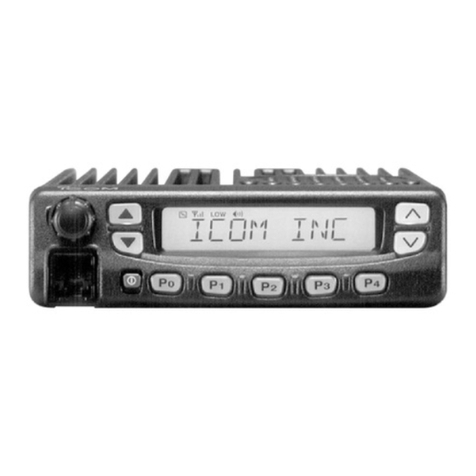
Icom
Icom IC-F620 Guide
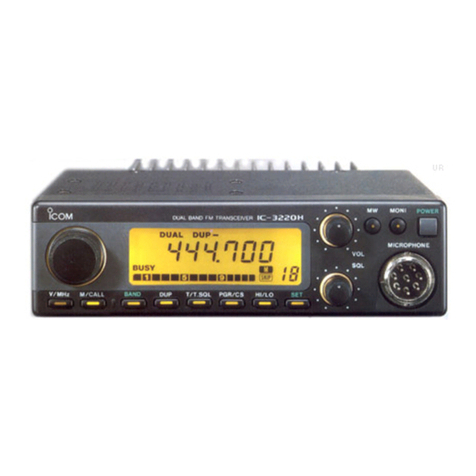
Icom
Icom IC-3220A User manual
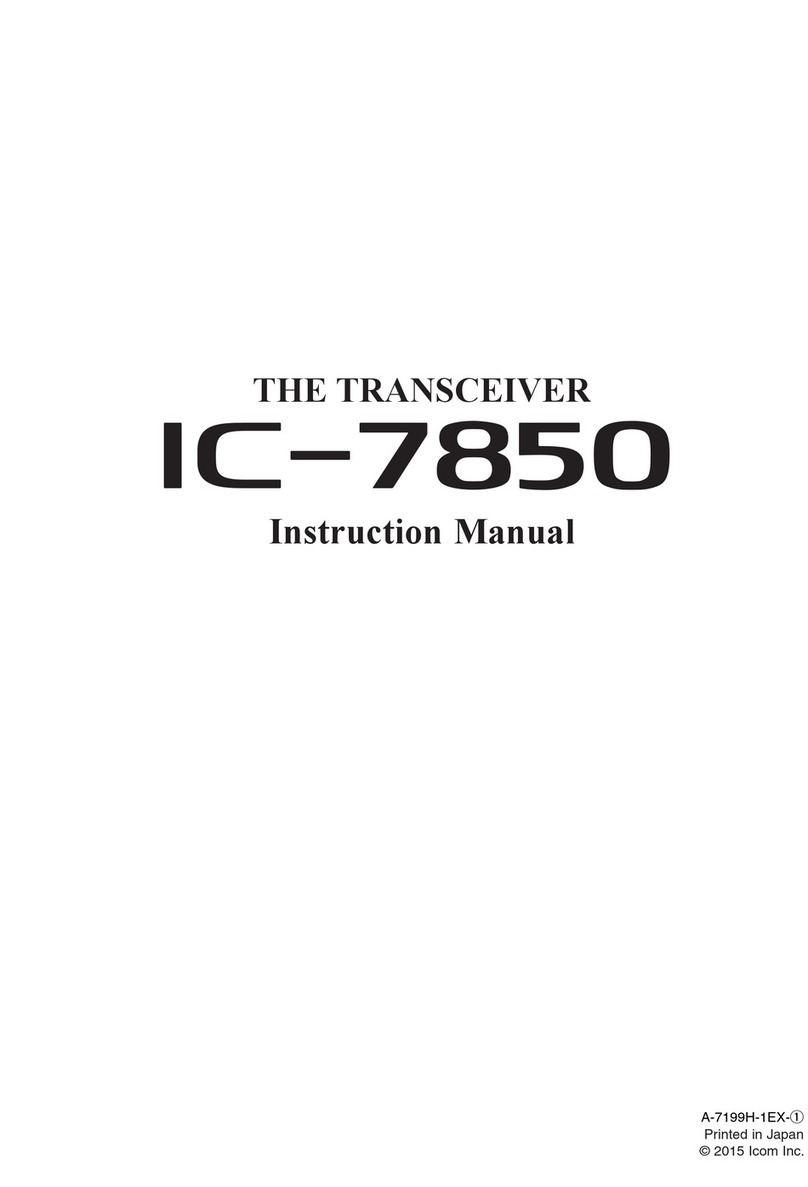
Icom
Icom iC-7850 User manual
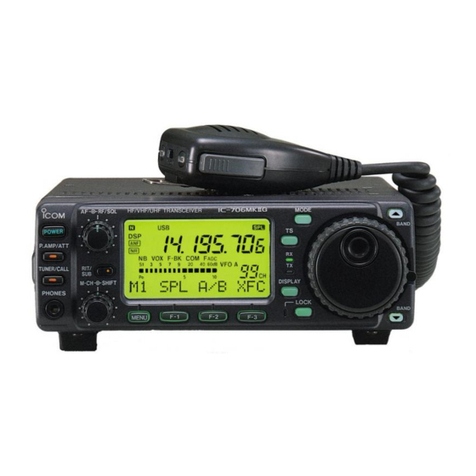
Icom
Icom IC-706 User manual
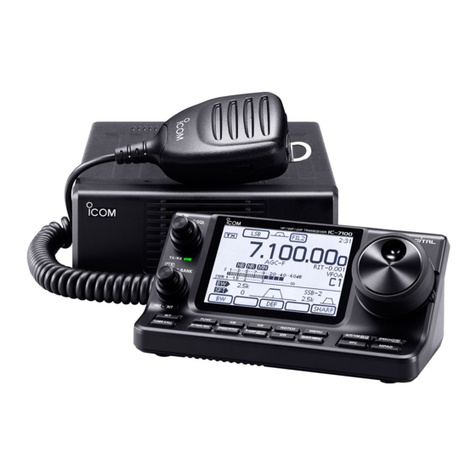
Icom
Icom IC-7100 Installation and operating instructions
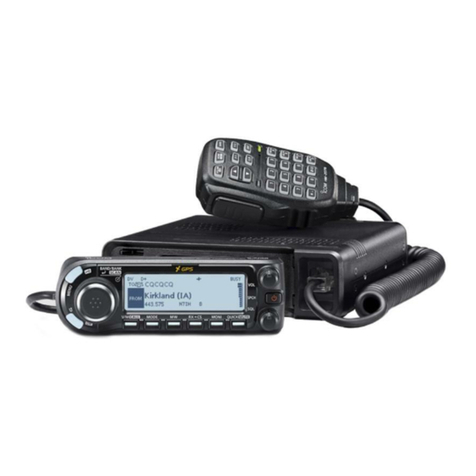
Icom
Icom D-STAR ID-4100A Setup guide

